Quiz Answer Key and Fun Facts
1. What was the relationship of Louis XV to his predecessor, Louis XIV?
2. Whom did Louis marry in 1725?
3. One of Louis' many mistresses was Louise Julie de Mailly-Nesle. She was the eldest of six sisters. Louis liked her so much he took her five sisters as mistresses too.
4. In 1733 Louis embarked on his first war by intervening in the War of the Polish Succession. The main goal was to check the power of which rival nation?
5. What was Louis' nickname in the early days of his reign?
6. Peace didn't last long and in 1740 France was at war again. In the War of the Austrian succession France was successful and conquered the entire Austrian Netherlands (present day Belgium). In the following peace talks Louis gave all this conquered territory back to Austria.
7. Under what name is Jeanne Antoinette Poisson better known?
8. Who tried to kill Louis XV in 1757?
9. In 1756 yet another war broke out. This time France would find itself on the losing end. The outcome of this war was that France lost its possessions in Canada, India and the Caribbean. The cost of this war also brought France on the edge of bankruptcy. In America this war is known as the 'French and Indian war'. Under what name is it also known in Europe.
10. Louis died of illness in 1774. Which disease caused his death?
Source: Author
AlonsoKing
This quiz was reviewed by FunTrivia editor
Snowman before going online.
Any errors found in FunTrivia content are routinely corrected through our feedback system.
